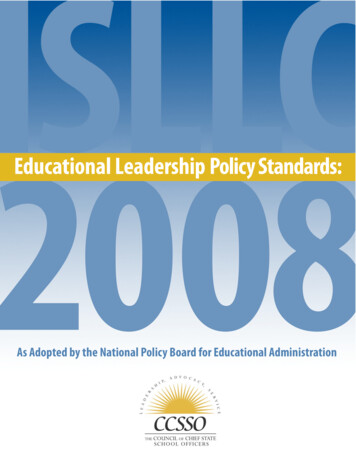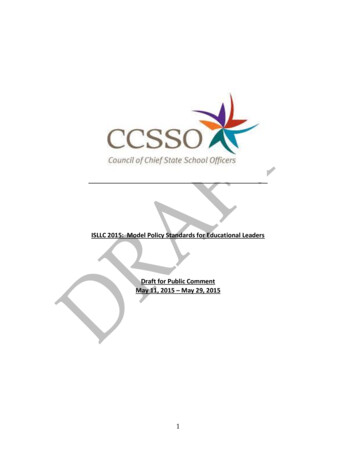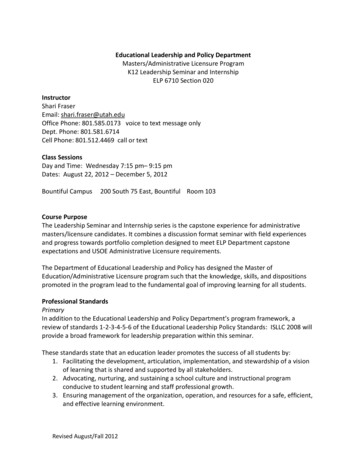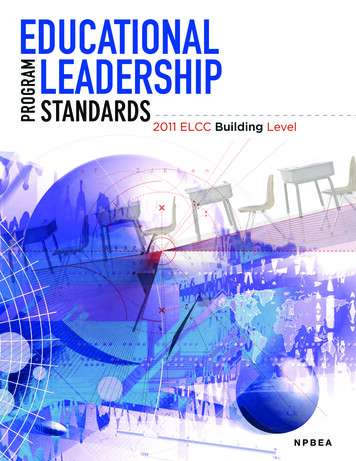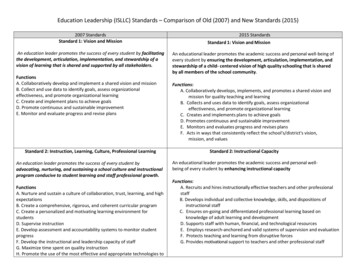
Transcription
Education Leadership (ISLLC) Standards – Comparison of Old (2007) and New Standards (2015)2007 StandardsStandard 1: Vision and MissionAn education leader promotes the success of every student by facilitatingthe development, articulation, implementation, and stewardship of avision of learning that is shared and supported by all stakeholders.FunctionsA. Collaboratively develop and implement a shared vision and missionB. Collect and use data to identify goals, assess organizationaleffectiveness, and promote organizational learningC. Create and implement plans to achieve goalsD. Promote continuous and sustainable improvementE. Monitor and evaluate progress and revise plans2015 StandardsStandard 1: Vision and MissionAn educational leader promotes the academic success and personal well-being ofevery student by ensuring the development, articulation, implementation, andstewardship of a child- centered vision of high quality schooling that is sharedby all members of the school community.Functions:A. Collaboratively develops, implements, and promotes a shared vision andmission for quality teaching and learningB. Collects and uses data to identify goals, assess organizationaleffectiveness, and promote organizational learningC. Creates and implements plans to achieve goalsD. Promotes continuous and sustainable improvementE. Monitors and evaluates progress and revises plansF. Acts in ways that consistently reflect the school's/district's vision,mission, and valuesStandard 2: Instruction, Learning, Culture, Professional LearningStandard 2: Instructional CapacityAn education leader promotes the success of every student byadvocating, nurturing, and sustaining a school culture and instructionalprogram conducive to student learning and staff professional growth.An educational leader promotes the academic success and personal wellbeing of every student by enhancing instructional capacityFunctionsA. Nurture and sustain a culture of collaboration, trust, learning, and highexpectationsB. Create a comprehensive, rigorous, and coherent curricular programC. Create a personalized and motivating learning environment forstudentsD. Supervise instructionE. Develop assessment and accountability systems to monitor studentprogressF. Develop the instructional and leadership capacity of staffG. Maximize time spent on quality instructionH. Promote the use of the most effective and appropriate technologies toFunctions:A. Recruits and hires instructionally effective teachers and other professionalstaffB. Develops individual and collective knowledge, skills, and dispositions ofinstructional staffC. Ensures on-going and differentiated professional learning based onknowledge of adult learning and developmentD. Supports staff with human, financial, and technological resourcesE. Employs research-anchored and valid systems of supervision and evaluationF. Protects teaching and learning from disruptive forcesG. Provides motivational support to teachers and other professional staff
support teaching and learningI. Monitor and evaluate the impact of the instructional programStandard 3: InstructionAn educational leader promotes the academic success and personal wellbeing of every student by promoting instruction that maximizes studentlearning.Functions:A. Maintains a culture of high expectations and challengeB. Ensures that instruction is authentic and relevant to students’ experiences andfuturesC. Ensures that instruction is anchored on best understandingsof child development and effective pedagogyD. Ensures student strengths-based approaches to teaching and learningE. Ensures the use of effective differentiated pedagogy and student supports toreduce learning gapsF. Provides ongoing, salient, informative, and actionable feedback toteachers and other professional staffG. Ensures the use of pedagogy that treats students as individuals andpromotes constructive sense of selfH. Ensures the presence of culturally responsive pedagogy that affirms studentidentitiesI. Monitors instruction and instructional timeJ. Employs technology in the service of teaching and learningStandard 4: Curriculum and AssessmentAn educational leader promotes the academic success and personal wellbeing of every student by promoting robust and meaningful curricula andassessment programs.Functions:A. Ensures academic rigorous and well-rounded curricular and assessmentprograms.B. Ensures culturally relevance in curricula and assessmentsC. Direct curricula and assessments to maximize opportunity for studentlearningD. Ensures authentic learning and assessment experiencesE. Emphasizes assessment systems congruent with understandingsof child development and technical standards of measurement
F. Ensures the use of learning experiences that enhance both enjoyment ofand success in learningG. Uses assessment data in ways that are appropriate to their intended usesand within their technical limitations.Standard 6: Professional Culture for Teachers and StaffAn educational leader promotes the academic success and personal well-beingof every student by promoting professionally-normed communities forteachers and other professional staff.Functions:A. Develops and supports productive and trusting working relationshipsB. Nurtures a commitment to shared goalsC. Provides for collaborative workD. Facilitates shared ownershipE. Develops collaborativeleadership skillsF. Promotes a climate ofcollective efficacyG. Monitors and nurtures a culture of shared accountability for colleagues, forstudents, and for the school as a wholeStandard 3: Operations and ManagementStandard 8: Operations and ManagementAn education leader promotes the success of every student by ensuringmanagement of the organization, operation, and resources for a safe,efficient, and effective learning environment.An educational leader promotes the academic success and personal wellbeing of every student by ensuring effective and efficient management ofthe school or district to promote student social and academic learning.FunctionsA. Monitor and evaluate the management and operational systemsB. Obtain, allocate, align, and efficiently utilize human, fiscal, andtechnologicalresourcesC. Promote and protect the welfare and safety of students and staffD. Develop the capacity for distributed leadershipE. Ensure teacher and organizational time is focused to support qualityinstructionand student learningFunctions:A. Develops and demonstrates well-honed interpersonal skillsB. Manages student behavior with a focus on learningC. Ensures effective leadership throughout the school or districtD. Crafts and connects management operations, policies, and resourcesto the vision and values of the schoolE. Monitors and evaluates all aspects of school or district operations foreffect and impactF. Ensures the implementation of data systems that provide actionableinformation
G. Uses technology at the school or district to improve operationsH. Manages organizational politics with an eye on school or districtvalues and missionI. Enables others to understand and support relevant laws and policiesJ. Acts as a steward of public fundsK. Develops and manages relationships with feeder and connecting schools.L. Develops and manages relationships with the district office or the schoolboardM. Acts entrepreneurially in the service of the school or districtN. Manages enrollment under conditions of competitionStandard 4: Engaging with Faculty and CommunityAn education leader promotes the success of every student bycollaborating with faculty and community members, responding todiverse community interests and needs, and mobilizing communityresources.FunctionsA. Collect and analyze data and information pertinent to the educationalenvironmentB. Promote understanding, appreciation, and use of the community’sdiversecultural, social, and intellectual resourcesC. Build and sustain positive relationships with families and caregiversD. Build and sustain productive relationships with community partnersStandard 7: Communities of Engagement for FamiliesAn educational leader promotes the academic success and personal wellbeing of every student by promoting communities of engagement forfamilies and other stakeholders in the school’s community.Functions:A. Promotes understanding, appreciation, and use of the community'sdiverse cultural, social, and intellectual resourcesB. Nurtures a sense of approachability and welcome and sustains positiverelationships with families and caregiversC. Builds and sustains productive relationships with community partnersin the government, non-profit, and private sectorsD. Advocates for policies and resources for the communityE. Is present in, understands, and engages with community needs,priorities, and resourcesF. Communicates regularly and openly with families and stakeholders in thewider communityG. Develops partnerships with families to support student learning athome.H. Monitors engagement with families and community.I. Represents the school effectively to parents and the community tomanage enrollments and secure support and resourcesStandard 5: Ethical Principles and Professional NormsStandard 9: Ethical Principles and Professional NormsAn education leader promotes the success of every student by acting withintegrity, fairness, and in an ethical manner.An educational leader promotes the academic success and personal wellbeing of every student by adhering to ethical principles and professionalnorms.
FunctionsA. Ensure a system of accountability for every student’s academic andsocial successB. Model principles of self-awareness, reflective practice, transparency,and ethical behaviorC. Safeguard the values of democracy, equity, and diversityD. Consider and evaluate the potential moral and legal consequences ofdecision makingE. Promote social justice and ensure that individual student needs informall aspects of schoolingStandard 6: Responding to the Education ContextFunctions:A. Nurtures the development of schools that place children at theheart of educationB. Acts in an open and transparent mannerC. Maintains a sense of self-awareness and attends to his or her own learningD. Works to create productive relationships with students, staff,parents, and members of the extended school communityE. Maintains a sense of visibility and is approachable to all stakeholdersF. Acts as a moral compass for the school or districtG. Safeguards the values of democracy, individual liberty, equity, justice,community, and diversityStandard 10: Equity and Cultural ResponsivenessAn education leader promotes the success of every student byunderstanding, responding to, and influencing the political, social,economic, legal, and cultural context.An educational leader promotes the academic success and personal wellbeing of every student by ensuring the development of an equitable andculturally responsive school.FunctionsA. Advocate for children, families, and caregiversB. Act to influence local, district, state, and national decisions affectingstudent learningC. Assess, analyze, and anticipate emerging trends and initiatives in orderto adapt leadership strategiesFunctions:A. Ensures equity of access to social capital and institutional supportB. Fosters and monitors schools as affirming and inclusive placesC. Advocates for children, families, and caregiversD. Attacks issues of student marginalization; deficit-based schooling; andlimiting assumptions about gender, sexual orientation, race, class,disability, and special statusE. Promotes the ability of students to participate in multiple culturalenvironmentsF. Promotes and monitors understanding, appreciation, and use of diversecultural, linguistic, ecological, social, political, and intellectualresourcesStandard 5: Community of Care for StudentsAn educational leader promotes the academic success and personal well-being ofevery student by promoting the development of an inclusive school climatecharacterized by supportive relationships and a personalized culture of care.
Functions:A. Ensures the formation of a culture defined by trustB. Ensures that each student is known, accepted and valued, respected, andfeels a sense of belonging.C. Ensures that students are enmeshed in a safe, secure, emotionallyprotective, and healthy environmentD. Ensures that each student has adequate, relevant, and sustained academicand social support that supports expectations for academic successE. Ensures that each student is an active member of and takes responsibilityfor the schoolF. Provides student with academic and social experiences that are congruentwith the cultures and languages of the communityStandard 11: Continuous School ImprovementAn educational leader promotes the academic success and personal wellbeing of every student by ensuring the development of a culture ofcontinuous school improvement.Functions:A. A n t i c i p a t e s , assesses, analyzes, and discerns the value of emergingtrends to shape school or district decision makingB. Initiates and manages school and system-wide changeC. Enables others to engage productively with improvement processesD. Navigates improvement efforts in the midst of ambiguity andcompeting demands and interests inside and outside the schooland districtE. Promotes a culture of evidence-based inquiry and continuous learninglinked to processes of planning, decision making, and implementation ofimprovementsF. Maintains a systems perspective and promotes alignment across alldimensions of the school or districtG. Promotes a culture of collective direction, shared engagement, andmutual accountability consistent with vision, mission, and values
F. Develop the instructional and leadership capacity of staff G. Maximize time spent on quality instruction H. Promote the use of the most effective and appropriate technologies to Standard 2: Instructional Capacity An educational leader promotes the academic success and personal well-being of every student by enhancing instructional capacity




